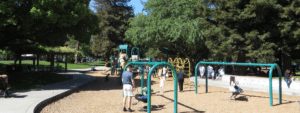Kevin Wing
General Plan 2030 approval includes so much more
Proponents and opponents of San Ramon’s Measure W agree on one thing: It is the hot-button item on the Nov. 2 ballot for San Ramon residents. While Danville residents don’t vote, the nearby unincorporated Tassajara Valley is of interested to the town.
Measure W asks San Ramon voters to approve the city’s General Plan for 2030, which includes plans to redevelop the North Camino Ramon area. But the biggest conflict is on whether to extend the city’s urban growth boundary to include rural Tassajara Valley to the east, the Norris Canyon region to the west, and a slight parcel on the southwest, which are now in unincorporated Contra Costa County.
Proponents of Measure W include Mayor Abram Wilson and the San Ramon City Council. City officials want to extend the city’s urban growth boundaries to protect the open space, not to develop it, said Planning Commissioner Eric Wallis.
“If Measure W wins, Tassajara Valley would not be developed,” said Wallis, who joined the Planning Commission this year. “The urban growth boundaries are designed for land-use management in specific areas, such as Tassajara Valley and Norris Canyon.”
Tassajara Valley is outside the county’s Urban Limit Line, passed in 2006. Wallis said San Ramon, Danville and the county are working to determine spheres of influence in the area and San Ramon’s will probably be west of Camino Tassajara and south of Highland Road to the Alameda County Line.
Phil O’Loane, a San Ramon planning commissioner until earlier this year, heads up the No on W campaign. He says there’s only one reason the city desires to expand its urban growth boundaries, and it’s not to preserve open space.
“The only reason to expand the urban growth boundaries would be if the city intends to do development,” O’Loane stated emphatically.
Wallis says the Citizens for San Ramon group, which supports Measure W, has received only $1,000 in donations as of Oct. 5, while the No on W camp has racked up more than $53,000, most of that coming from environmentalists.
“If you look at who’s financing the No on W campaign the most, it’s coming from people who don’t even live in San Ramon,” Wallis said.
O’Loane agrees that the No on W campaign is supported by environmental groups such as the Greenbelt Alliance and Save Mount Diablo.
Opponents point out that Measure W allows the development of 1,624 acres in Tassajara Valley, as well as 608 acres in the hills along Norris Canyon, west of Interstate 680.
But Wallis, speaking on behalf of the city, says these parties are wrong in claiming that a revised urban growth boundary will cause massive development in Tassajara, such as what occurred in the Dougherty Valley, most of which has been annexed to San Ramon.
Dougherty Valley development, begun in 1996, was scheduled for 11,000 housing units including single-family homes, townhouses and apartments. The development has slowed due to the recession and 70 percent has been built thus far.
When Dougherty Valley was being developed, it was under county control. As each of the new neighborhoods in the master-planned Gale Ranch and Windemere communities was built and new residents moved in, San Ramon annexed them, sometimes block by block, according to Wallis.
“The Dougherty Valley was inside the urban limit line for San Ramon at the time it was first being built,” says O’Loane. “Look at it now.”
The only way to keep Tassajara Valley rural is to secure the area under local control, said Wallis, and Measure W opponents are ill-advised in thinking the county will keep the Tassajara Valley agricultural.
“What No on W ignores,” Wallis said, “is that area is within the county’s planning standards and not San Ramon’s.”
O’Loane says he does not understand why San Ramon officials will not focus their attentions elsewhere before trying to swallow up the Tassajara Valley.
“The city has so many other areas to focus on,” he says. “Finish the Dougherty Valley. The city should also focus on building the City Center. There’s no reason to expand at this point.”
O’Loane also says that with expanding boundaries comes the potential for moving school boundaries, another contentious issue with families who move to certain neighborhoods so their children can attend high-performing schools.
“That’s one thing I’m concerned about,” says Maria Medrano-Davies, a San Ramon resident. Her family lives in Gale Ranch, and she’s fearful that one day her two young children will not be able to attend nearby Coyote Creek Elementary.
“I’m concerned about the city growing the way it has,” Medrano-Davies said. “The city is growing so fast, and traffic getting across town along Bollinger (Canyon Road) is a mess in the morning, and it’s a mess in the afternoon.”
San Ramon, incorporated in 1983, has been on a fast track for growth since the mid-1980s. For two decades, homes were concentrated in southern San Ramon along Alcosta Boulevard, and in the northwestern section of the city, west of San Ramon Valley Boulevard.
When the 585-acre Bishop Ranch Business Park opened in the early 1980s, anchored by major employers Chevron, AT&T and Toyota, the city looked at zoning other areas for homes for employees. Today the business park has more than 300 companies with 30,000 employees.
San Ramon’s population is estimated at 65,000, up nearly 23,000 residents from the 2000 census. The city predicts its population will grow to 100,000 by 2030.
Measure W opponents such as O’Loane say the move to expand the city’s urban growth boundaries should make voters think about the city’s future intentions.
“One planning director told me once that growth in the Tassajara Valley is inevitable,” O’Loane says. “It makes people wonder.”
But Wallis says San Ramon officials are continually looking at ways to develop policies that would combat global warming and cut down on the amount of traffic throughout the region.
“Along with smart growth policies, we are preparing an element that encapsulates all of these provisions,” he said.
While Tassajara Valley remains rural, farmers and ranchers lease some of the land from developers, who bought the property more than 25 years ago, said Wallis.
Plans have been submitted to the county for a development for Tassajara Valley called New Farm with 186 houses; also a cemetery has been proposed. Both sides note that homes in the area use well water and water would have to be procured for more development. The approval process would include deciding whether these projects violate the county’s urban limit line, whether they are considered urban uses.
Farther north on Camino Tassajara, Alamo Creek and Wendt Ranch developments have been built in the last few years on the eastern edge of Danville, and the town is currently doing an analysis to determine whether it makes sense to annex them.
Danville will likely request that its sphere of influence extend only as far south as Finley Road, per an agreement worked out with San Ramon and the county, said Danville Councilwoman Candace Andersen.
“The town has not changed its position that the voter-approved Urban Limit Line should be honored,” she added.
If there were any kind of threat that Danville town officials have their eyes on the Tassajara Valley, O’Loane says, that’s not the case.
“Danville has expressed no interest in expanding its urban growth boundary line,” he said, adding there is no reason for San Ramon to extend its boundary to encompass Tassajara Valley to protect its open space.
Measure W also includes extending Ordinance 197 for another five years “to protect ridgelines, creeks and open space,” although opponents say any areas covered by the ordinance have already been developed or are protected by other means, and this is a smokescreen to make the measure appear environmentally friendly.
Residents of San Ramon — and Danville — will be watching closely Nov. 2 to see the results for Measure W.
###





